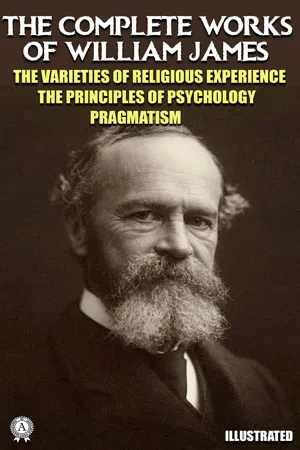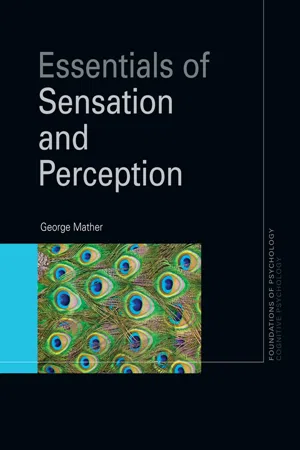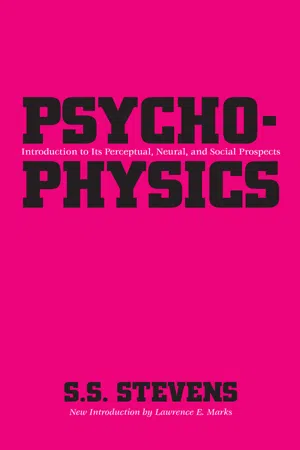Ernst Weber
Ernst Weber was a German physician and psychologist known for his work in psychophysics. He is best known for Weber's Law, which describes the relationship between the magnitude of a physical stimulus and the perception of change in that stimulus. Weber's work laid the foundation for the study of sensory perception and the understanding of the human senses.
6 Key excerpts on "Ernst Weber"
- eBook - ePub
The Complete Works of William James. Illustrated
The Varieties of Religious Experience. The Principles of Psychology. Pragmatism
- William James(Author)
- 2021(Publication Date)
- Strelbytskyy Multimedia Publishing(Publisher)
...Gustav Theodor Fechner first proved it to be a law for all departments of sensation. Psychology owes to him the first comprehensive investigation of sensations from a physical point of view, the first basis of an exact Theory of Sensibility.” So much for a general account of what Fechner calls Weber’s law. The ‘exactness’ of the theory of sensibility to which it leads consists in the supposed fact that it gives the means of representing sensations by numbers. The unit of any kind of sensation will be that increment which, when the stimulus is increased, we can just barely perceive to be added. The total number of units which any given sensation contains will consist of the total number of such increments which may be perceived in passing from no sensation of the kind to a sensation of the present amount. We cannot get at this number directly, but we can, now that we know Weber’s law, get at it by means of the physical stimulus of which it is a function. For if we know how much of the stimulus it will take to give a barely perceptible sensation, and then what percentage of addition to the stimulus will constantly give a barely perceptible increment to the sensation, it is at bottom only a question of compound interest to compute, out of the total amount of stimulus which we may be employing at any moment, the number of such increments, or, in other words, of sensational units to which it may give rise. This number bears the same relation to the total stimulus which the time elapsed bears to the capital plus the compound interest accrued. To take an example: If stimulus A just falls short of producing a sensation, and if r be the percentage of itself which must be added to it to get a sensation which is barely perceptible – call this sensation 1 – then we should have the series of sensation-numbers corresponding to their several stimuli as follows: Sensation 0 = stimulus A; “1 = “A (1 + r); “2 = “A (1 + r) 2 ; “3 = “A (1 + r) 3 ;. . . . . . . . . . . . . . . . . . ...
- Michael D. Breed(Author)
- 2017(Publication Date)
- Academic Press(Publisher)
...Nevertheless, psychophysical laws are quite important in understanding signal production and reception in animal behavior and they deserve a central spot in studies of the evolution of communication. The psychophysical laws have considerable explanatory power in sensory physiology and help to explain much about how animals use signals. See also Chapter 12, 1914 Sensory Physiology and Behavior; Chapter 14, 1940 Orientation; Chapter 15, 1941 Bat Echolocation; Chapter 66, 1991 Receiver Psychology; Chapter 73, 1999 Multimodal Communication. References and Suggested Reading 1. Anon. Weber, Ernst Heinrich, biographical entry at Encyclopedia.com. < http://www.encyclopedia.com/topic/Ernst_Heinrich_Weber.aspx#1-1G2:2830904576-full >. 2. Dawson PM. The life and work of Ernest Heinrich Weber. Phi Beta Pi Quarterly. 1928;25:86–116. 3. Horeman HW. Neural effects and the psychophysical law. Nature. 1963;200:1241. 4. Stevens SS. On the psychophysical law. Psychol Rev. 1957;64:153–181....
- eBook - ePub
- William James(Author)
- 2018(Publication Date)
- Perlego(Publisher)
...The determination of the unit of stimulus is, however, so hard here that I will give no figures. The results may be found in Wundt's Physiologische Psychologie, 3d Ed. i, 370-2. The discrimination of lengths by the eye has been found also to obey to a certain extent Weber's law. The figures will all be found in G. E. Müller, op. cit. part ii, chap. x, to which the reader is referred. Professor Jastrow has published some experiments, made by what may be called a modification of the method of equal-appearing differences, on our estimation of the length of sticks, by which it would seem that the estimated intervals and the real ones are directly and not logarithmically proportionate to each other. This resembles Merkel's results by that method for weights, lights, and sounds, and differs from Jastrow's own finding about star-magnitudes. [458] If we look back over these facts as a whole, we see that it is not any fixed amount added to an impression that makes us notice an increase in the latter, but that the amount depends on how large the impression already is. The amount is expressible as a certain fraction of the entire impression to which it is added; and it is found that the fraction is a well-nigh constant figure throughout an entire region of the scale of intensities of the impression in question. Above and below this region the fraction increases in value. This is Weber's law, which in so far forth expresses an empirical generalization of practical importance, without involving any theory whatever or seeking any absolute measure of the sensations themselves...
- eBook - ePub
- George Mather(Author)
- 2014(Publication Date)
- Routledge(Publisher)
...Starting from the initial detection of a very weak stimulus (a tiny weight, a dim light), he reasoned that if you were to count up just noticeable differences in stimulus intensity you would actually be counting up equal sensory intervals along a subjective, psychological scale of perceived magnitude. So a small increment to a light weight (or a dim light, or a quiet sound) would produce the same increase in perceived weightiness (or brightness or loudness) as a large increment to a very heavy weight (or a bright light, or a loud sound). This insight became known as Fechner’s Law, and it had a fundamental impact on psychology and physiology. It offered the beginnings of an answer to an age-old philosophical problem, the relation between mind and body, the mental (psychical) world and the physical world. Fechner had discovered a simple mathematical link between the laws of the mind and the laws of physics; a psychophysical law. He went on to work out and formalize a set of psychophysical methods for measuring JNDs. Variants of these methods are still in use today to measure both JNDs and other more complex psychophysical phenomena, and they still yield insights about sensory function that could not be obtained by any other means. Key Term Fechner’s Law. A principle describing the relationship between sensation magnitude and stimulus magnitude. Key Concept Psychophysical threshold In Elemente der Psychophysik, published in 1860, Fechner described several experimental methods to measure the relation between sensory stimuli and perceptual responses, and these methods have been refined over the years to improve their reliability. As an example, consider a simple ‘yes/no’ psychophysical method to measure the relation between stimulus intensity and detection. The participant is presented with a stimulus, and asked to respond ‘yes’ or ‘no’ to indicate whether they can detect it or not...
- eBook - ePub
Psychophysics
Introduction to Its Perceptual, Neural and Social Prospects
- S.S. Stevens(Author)
- 2017(Publication Date)
- Routledge(Publisher)
...CHAPTER 1 The Psychophysical Law It has taken some homely and simple procedures to reveal beautiful and elegant relations in the behavior of the sensory system. Recently invented procedures have shown that whenever the stimulus increases, the intensity of the sensation grows in accordance with a common basic principle. In every sense modality, sensation is a power function of stimulus. The principle seems clear and straightforward now, but it was a zigzag path with many wrong forks that led finally to the discovery that equal stimulus ratios produce equal sensation ratios. That is the basic principle that underlies the psychophysical law. The ratio invariance tells us that the psychophysical law is a power function. It is not easy, after the fact, to single out exactly those blocks and diversions that deflected progress, my own included, from a straight course toward the psychophysical law, for experience has meaning only against the background of the Zeitgeist, which permeates our thinking and determines what, in any given time period, is in fact thinkable. I find that I can think now about quantitative relations among sensations that were scarcely conceivable four decades ago—relations that were deemed quite beyond imagining a hundred years ago. Barriers of belief had to be breached in order to forge a fresh paradigm. It was not only that laboratory traditions were encrusted with rules and procedures that blocked the way, but before it became possible to think more clearly about the measurement of sensation, the nature and meaning of measurement had to be understood in a revised light. What by common consent was unmeasurable a century ago has now been measured, and in the process there has emerged a restructuring of psychophysics that provides a new perspective on the ancient problem of the relation of stimulus to sensation...
- Wilhelm Wundt(Author)
- 2014(Publication Date)
- Routledge(Publisher)
...Our reference of Weber’s law to the principle of the relativity of sensations favours the second of these interpretations. Our comparison is always relative. In order that a more intensive sensation-magnitude may increase by as much as a lesser sensation, the sensation-increase must be correspondingly greater; and two sensation-increases which lie at different parts of the sensation-scale will be equally noticeable when they stand in equal relations to the stimulation-intensities to which they are added....





